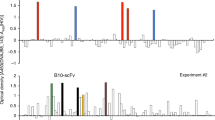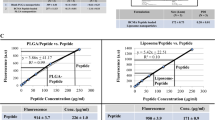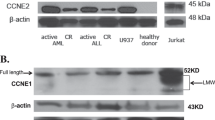Abstract
X-box binding protein 1 (XBP1), CD138 (Syndecan-1) and CS1 (SLAMF7) are highly expressed antigens in cancers including multiple myeloma (MM). Here, we identify and characterize immunogenic HLA-A24 peptides derived from these antigens for potential vaccination therapy of HLA-A24+ patients with MM. The identified immunogenic HLA-A24-specific XBP1 unspliced (UN)185–193 (I S P W I L A V L), XBP1 spliced (SP)223–231 (V Y P E G P S S L), CD138265–273 (I F A V C L V G F) and CS1240–248 (L F V L G L F L W) peptides induced antigen-specific CTL with anti-MM activity in an HLA-A24 restricted manner. Furthermore, a cocktail containing the four HLA-A24 peptides evoked MM-specific CTL with distinct phenotypic profiles (CD28, CD40L, 41BB, CD38, CD69) and anti-tumor activities, evidenced by perforin upregulation, CD107a degranulation (cytotoxicity) and Th1-type cytokines (IFN-γ/IL-2/TNF-α) production in response to HLA-A24+ MM cells. The multipeptide-specific CTL included antigen-specific memory CD8+ T cells expressing both T-cell activation (CD38, CD69) and immune checkpoints antigens (CTLA, PD-1, LAG-3, TIM-3). These results provide the framework for a multipeptide vaccination therapy to induce tumor-specific CTL in HLA-A24-positive patients with myeloma and other cancers expressing these antigens.
This is a preview of subscription content, access via your institution
Access options
Subscribe to this journal
Receive 12 print issues and online access
$259.00 per year
only $21.58 per issue
Buy this article
- Purchase on Springer Link
- Instant access to full article PDF
Prices may be subject to local taxes which are calculated during checkout









Similar content being viewed by others
References
Kyle RA, Rajkumar SV . Criteria for diagnosis, staging, risk stratification and response assessment of multiple myeloma. Leukemia 2009; 23: 3–9.
Anderson KC, Carrasco RD . Pathogenesis of myeloma. Annu Rev Pathol 2011; 6: 249–274.
Munsh NC, Anderson KC, Bergsagel PL, Shaughnessy J, Palumbo A, Durie B et al. Consensus recommendations for risk stratification in multiple myeloma: report of the International Myeloma Workshop Consensus Panel 2. Blood 2011; 117: 4696–4700.
Brimnes MK, Vangsted AJ, Knudsen LM, Gimsing P, Gang AO, Johnsen HE et al. Increased level of both CD4+FOXP3+ regulatory T cells and CD14+ HLA-DRlow myeloid-derived suppressor cells and decreased level of dendritic cells in patients with multiple myeloma. Scand J Immunol 2010; 72: 540–547.
Beyer M, Kochanek M, Giese T, Endl E, Weihrauch MR, Knolle PA et al. In vivo peripheral expansion of naive CD4+CD25high FoxP3+ regulatory T cells in patients with multiple myeloma. Blood 2006; 107: 3940–3949.
Rutella S, Danese S, Leone G . Tolerogenic dendritic cells: cytokine modulation comes of age. Blood 2006; 108: 1435–1440.
Rutella S, Locatelli F . Targeting multiple-myeloma-induced immune dysfunction to improve immunotherapy outcomes. Clin Dev Immunol 2012; 2012: 196063.
Lee JJ, Choi BH, Kang HK, Park MS, Park JS, Kim SK et al. Induction of multiple myeloma-specific cytotoxic T lymphocyte stimulation by dendritic cell pulsing with purified and optimized myeloma cell lysates. Leuk Lymphoma 2007; 48: 2022–2031.
Yi Q, Szmania S, Freeman J, Qian J, Rosen NA, Viswamitra S et al. Optimizing dendritic cell-based immunotherapy in multiple myeloma: intranodal injections of idiotype-pulsed CD40 ligand-matured vaccines led to induction of type-1 and cytotoxic T-cell immune responses in patients. Br J Haematol 2010; 150: 554–564.
Bae J, Carrasco R, Lee AH, Prabhala R, Tai YT, Anderson KC et al. Identification of novel myeloma-specific XBP1 peptides able to generate cytotoxic T lymphocytes: a potential therapeutic application in multiple myeloma. Leukemia 2011; 25: 1610–1619.
Bae J, Tai YT, Anderson KC, Munshi NC . Novel epitope evoking CD138 antigen-specific cytotoxic T lymphocytes targeting multiple myeloma and other plasma cell disorders. Br J Haematol 2011; 155: 349–361.
Bae J, Song W, Smith R, Daley J, Tai YT, Anderson KC et al. A novel immunogenic CS1-specific peptide inducing antigen-specific cytotoxic T lymphocytes targeting multiple myeloma. Br J Haematol 2012; 157: 687–701.
Kabaker K, Shell K, Kaufman HL . Vaccines for colorectal cancer and renal cell carcinoma. Cancer J 2011; 17: 283–293.
Rezvani K, de Lavallade H . Vaccination strategies in lymphomas and leukaemias: recent progress. Drugs 2011; 71: 1659–1674.
Bae J, Prabhala R, Voskertchian A, Brown A, Maguire C, Richardson P et al. A multiepitope of XBP1, CD138 and CS1 peptides induces myeloma-specific cytotoxic T lymphocytes in T cells of smoldering myeloma patients. Leukemia 2015; 29: 218–229.
Bae J, Smith R, Daley J, Mimura N, Tai YT, Anderson KC et al. Myeloma-specific multiple peptides able to generate cytotoxic T lymphocytes: a potential therapeutic application in multiple myeloma and other plasma cell disorders. Clin Cancer Res 2012; 18: 4850–4860.
Kuranda K, Berthon C, Dupont C, Wolowiec D, Leleu X, Polakowska R et al. A subpopulation of malignant CD34+CD138+B7-H1+ plasma cells is present in multiple myeloma patients. Exp Hematol 2010; 38: 124–131.
Liu J, Hamrouni A, Wolowiec D, Coiteux V, Kuliczkowski K, Hetuin D et al. Plasma cells from multiple myeloma patients express B7-H1 (PD-L1) and increase expression after stimulation with IFN-{gamma} and TLR ligands via a MyD88-, TRAF6-, and MEK-dependent pathway. Blood 2007; 110: 296–304.
Romano A, Conticello C, Cavalli M, Vetro C, La Fauci A, Parrinello NL et al. Immunological dysregulation in multiple myeloma microenvironment. Biomed Res Int 2014; 2014: 198539.
Joshua D, Suen H, Brown R, Bryant C, Ho PJ, Hart D et al. The T cell in myeloma. Clin Lymphoma Myeloma Leuk 2016; 16: 537–542.
Tucci M, Stucci S, Savonarola A, Ciavarella S, Cafforio P, Dammacco F et al. Immature dendritic cells in multiple myeloma are prone to osteoclast-like differentiation through interleukin-17A stimulation. Br J Haematol 2013; 161: 821–831.
Podar K, Richardson PG, Hideshima T, Chauhan D, Anderson KC . The malignant clone and the bone-marrow environment. Best Pract Res Clin Haematol 2007; 20: 597–612.
Dhodapkar MV, Krasovsky J, Osman K, Geller MD . Vigorous premalignancy-specific effector T cell response in the bone marrow of patients with monoclonal gammopathy. J Exp Med 2003; 198: 1753–1757.
Nooka AJ, Wang M, Yee AJ, Thomas SK, O'Donnell EK, Shah JJ et al. Final results of a phase 1/2a, dose escalation study of Pvx-410 multi-peptide cancer vaccine in patients with smoldering multiple myeloma (SMM). Am Soc Hematol 2016; 128: 2124.
Bae J, Samur M, Munshi A, Hideshima T, Keskin D, Kimmelman A et al. Heteroclitic XBP1 Peptides evoke tumor-specific memory cytotoxic T lymphocytes against breast cancer, colon cancer and pancreatic cancer cells. OncoImmunology 2014; 3: e970914.
Bae J, Keskin D, Cowens K, Lee AH, Dranoff G, Munshi NC et al. Lenalidomide polarizes Th1-specific anti-rumor immune response and expands XBP1 antigen-specific central memory CD3+CD8+ T cells against various solid tumors. J Leuk 2015; 3: 178–190.
Isakoff S, Tolaney S, Tung N, Adams S, Hussein H, Brachtel E et al. A Phase 1b study of safety and immune response to PVX-410 vaccine alone and in combination with Durvalumab in HLA-A2+ subjects following standard treatment of stage II or III triple negative breast cancer. Am Soc Clin Oncol 2017; 35: 15.
Olson JA, Jameson SC . Keeping STATs on memory CD8+ T cells. Immunity 2011; 35: 663–665.
Pages F, Berger A, Camus M, Sanchez-Cabo F, Costes A, Molidor R et al. Effector memory T cells, early metastasis, and survival in colorectal cancer. N Engl J Med 2005; 353: 2654–2666.
Junker N, Kvistborg P, Køllgaard T, Straten Pt, Andersen MH, Svane IM . Tumor associated antigen specific T-cell populations identified in ex vivo expanded TIL cultures. Cell Immunol 2012; 273: 1–9.
Dobrzanski MJ, Reome JB, Hylind JC, Rewers-Felkins KA, Abdulsamad K, Adams SL . Ag-specific type 1 CD8 effector cells enhance methotrexate-mediated antitumor responses by modulating endogenous CD49b-expressing CD4 and CD8 T effector cell subpopulations producing IL-10. Immunol Invest 2008; 37: 315–338.
Ye SW, Wang Y, Valmori D, Ayyoub M, Han Y, Xu XL et al. Ex-vivo analysis of CD8+ T cells infiltrating colorectal tumors identifies a major effector-memory subset with low perforin content. J Clin Immunol 2006; 26: 447–456.
Fearon DT, Manders P, Wagner SD . Arrested differentiation, the self-renewing memory lymphocyte, and vaccination. Science 2001; 293: 248–250.
Acknowledgements
The authors acknowledge the generous gift of T2-A*2401 cells from Dr Y Miyahara at Mie University School of Medicine (Mie, Japan) and Dr E Jaffee at the Johns Hopkins University School of Medicine (Baltimore). We also thank Mr John Daley and Ms Suzan Lazo-Kallanian from the flow cytometry facility at Dana-Farber Cancer Institute for providing flow cytometry assistance. This work was supported in part by grants from the National Institutes of Health Grants RO1-124929 to Dr Nikhil C Munshi, P50-100007, PO1-78378 and PO1155258 to Drs Kenneth C Anderson and Nikhil C Munshi, and RO1-50947 to Dr Kenneth C Anderson. Dr Kenneth C Anderson is an American Cancer Society Clinical Research Professor.
Author information
Authors and Affiliations
Corresponding author
Ethics declarations
Competing interests
NC Munshi is an honorarium of Celgene, Millennium and Novartis; KC Anderson is an honorarium of Celgene, Millennium and Onyx; and PGR Richardson is an honorarium of Celgene, Millennium and Johnson & Johnson. NC Munshi, KC Anderson and J Bae have ownership interest and are advisory board members in OncoPep Inc. The remaining authors declare no conflict of interest.
Additional information
Supplementary Information accompanies this paper on the Leukemia website
Supplementary information
Rights and permissions
About this article
Cite this article
Bae, J., Hideshima, T., Zhang, G. et al. Identification and characterization of HLA-A24-specific XBP1, CD138 (Syndecan-1) and CS1 (SLAMF7) peptides inducing antigens-specific memory cytotoxic T lymphocytes targeting multiple myeloma. Leukemia 32, 752–764 (2018). https://doi.org/10.1038/leu.2017.316
Received:
Revised:
Accepted:
Published:
Issue Date:
DOI: https://doi.org/10.1038/leu.2017.316
This article is cited by
-
From bench to bedside: targeting lymphocyte activation gene 3 as a therapeutic strategy for autoimmune diseases
Inflammation Research (2023)
-
Targeting LAG3/GAL-3 to overcome immunosuppression and enhance anti-tumor immune responses in multiple myeloma
Leukemia (2022)
-
Upregulation of CD38 expression on multiple myeloma cells by novel HDAC6 inhibitors is a class effect and augments the efficacy of daratumumab
Leukemia (2021)
-
Therapeutic vaccination against leukaemia via the sustained release of co-encapsulated anti-PD-1 and a leukaemia-associated antigen
Nature Biomedical Engineering (2020)
-
Selective targeting of multiple myeloma by B cell maturation antigen (BCMA)-specific central memory CD8+ cytotoxic T lymphocytes: immunotherapeutic application in vaccination and adoptive immunotherapy
Leukemia (2019)



